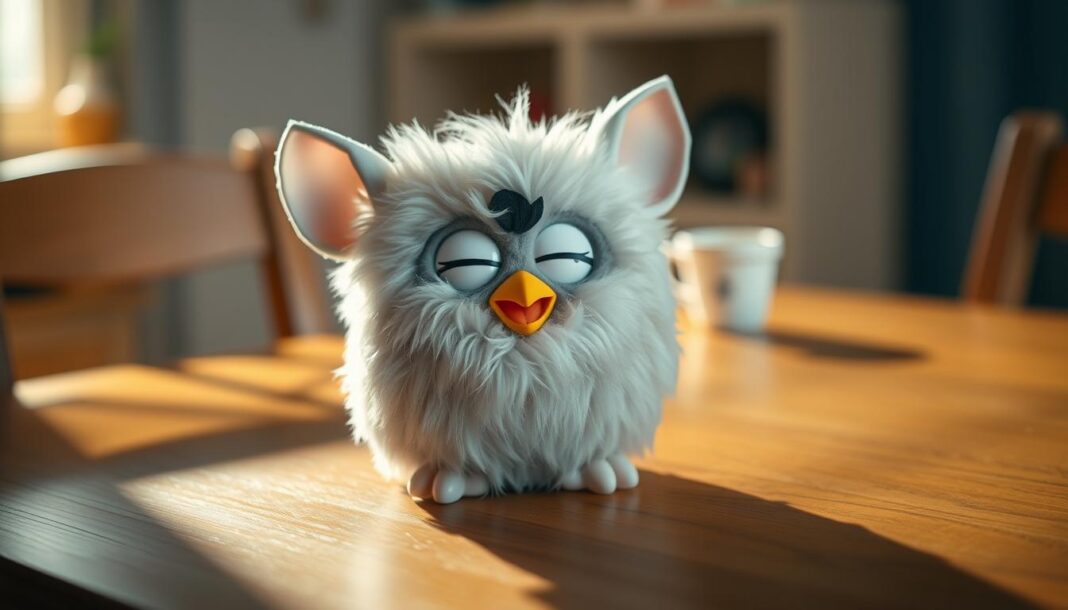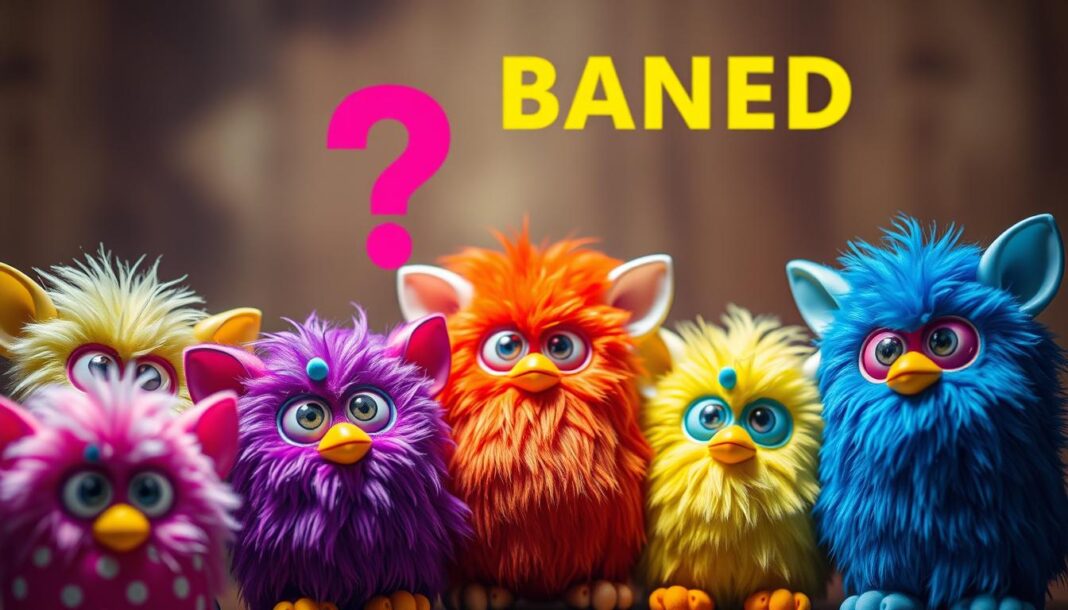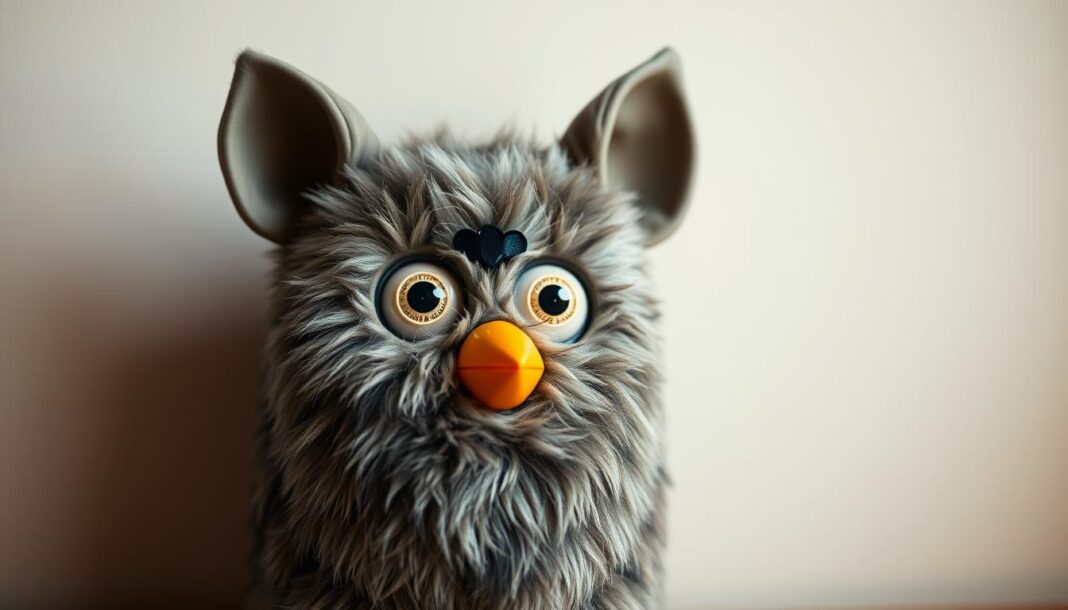In 1998, Tiger Electronics revolutionized the toy industry with the introduction of Furby, an electronic robotic toy that could seemingly learn and develop its own unique communication skills over time.
With over 40 million units sold in just three years, Furby became a cultural phenomenon, captivating children and collectors alike with its ability to interact and communicate in a way that was both fascinating and endearing.
We’re diving into the world of Furbish, exploring how these interactive toys process and respond to interactions, creating a personalized experience for their owners.
By understanding the evolution of Furby’s unique language across different generations, we can appreciate the groundbreaking approach to interactive toy design that continues to captivate audiences today.
The Fascinating World of Furby Communication
In the world of toys, Furby’s conversational skills stand out as a pioneering achievement. Furbies were the first successful attempt to produce and sell a domestically aimed robot that could interact conversationally. This innovation sparked widespread interest and curiosity about the potential of interactive toys.
We understand that Furby’s communication abilities created a sensation because they represented a breakthrough in domestic robot technology. The appeal of Furby communication lies in its ability to create the illusion of a living, learning companion that responds to care and attention. This interactive capability fosters an emotional connection between the Furby and its owner.
What Makes Furby Language Unique
Furby’s language is unique due to its gradual development process, which creates a rewarding experience as owners witness their Furby “growing” linguistically over time. The Furby’s ability to learn and adapt makes it feel more like a pet than an inanimate object. This characteristic has contributed significantly to its appeal.
| Feature | Description | Impact |
|---|---|---|
| Interactive Communication | Furby responds to user interaction | Creates emotional connection |
| Gradual Language Development | Furby learns and adapts over time | Rewarding experience for owners |
| Companion Illusion | Furby simulates a living companion | Fosters care and nurturing behavior |
The Appeal of Interactive Toy Communication
The appeal of interactive toy communication, as seen in Furbies, lies in its ability to tap into our fundamental desire for reciprocal interaction. Children and adults alike are drawn to the emotional connection fostered through interactive language exchange. Even in today’s world of advanced technology, the simple joy of communicating with a Furby continues to captivate new generations.
Furby’s pioneering approach to toy communication has set a standard for interactive playthings that continues to influence the industry today. The emotional bond formed between a Furby and its owner is a testament to the power of interactive communication in toys.
The Evolution of Furby: From 1998 to Present
Since its inception in 1998, Furby has come a long way, with each new generation bringing advancements in language capabilities and interactive features. The journey of Furby is a testament to the rapid evolution of interactive toys and their ability to engage users through sophisticated communication systems.
Original Furby and Its Communication Features
The original Furby, launched in 1998, was a groundbreaking electronic toy that could interact with users through a unique language known as Furbish. It was capable of speaking in nine different languages, which was a remarkable feature at the time. The Furby’s ability to communicate and respond to user interactions was made possible through a combination of pre-recorded sounds and simple algorithms.
The original Furby’s features included a range of sounds and movements that simulated interaction. Although it was relatively simple compared to modern standards, it captured the imagination of many and set the stage for future developments.
How Modern Furbies Have Advanced Their Language Capabilities
Modern Furbies have made significant strides in their language capabilities, incorporating advanced technologies such as voice recognition and mobile apps. The 2005 Emoto-Tronic Furbies, for example, introduced voice recognition technology, allowing for more natural interactions between Furby and its owner.
- The 2012 Furbies incorporated mobile apps that expanded their language capabilities and interactive potential beyond the physical toy.
- By 2016, Furby Connect was released with color LCD eyes, further enhancing the interactive experience.
- The latest generation, released in 2023, represents the culmination of decades of development, with enhanced language capabilities that build upon the original concept while incorporating modern technology.
Today’s Furbies can recognize and respond to a wider range of commands and stimuli, creating more dynamic conversations. The language features have expanded from the original nine languages to fourteen in later models, making Furbies truly international companions.
Understanding Furbish: The Native Furby Language
At the core of the Furby’s interactive capabilities is Furbish, a language designed to be both functional and endearing. As we explore the intricacies of Furbish, we gain a deeper understanding of how Furbies communicate and interact with their users.
Origins and Development of Furbish
Furbish was created as a unique language for the Furby, allowing it to communicate in a way that felt both alien and endearing to users. The language wasprogrammed to evolve, with Furbies speaking less Furbish and more English as they “grow.” This transition was carefully designed to maintain grammatical consistency while introducing new vocabulary. For more insights into the original Furby and its communication features, you can visitthis resource.
Furbish consists primarily of short, simple words with recognizable patterns. The language incorporates distinctive sounds that are consistent across different Furbish words, creating a cohesive phonetic system.
Basic Structure and Phonetics of Furbish
Breaking down the linguistic components of Furbish reveals consistent phonetic patterns and structural elements that make it feel like a real language. Furbish words typically follow consonant-vowel-consonant structures that are easy for the toy to pronounce.
Common Furbish phrases follow predictable patterns, with question words at the beginning and a rising intonation for inquiries, mimicking natural language structures. The language also incorporates emotional sounds and inflections that convey meaning beyond the words themselves, adding depth to the communication system.
| Furbish Feature | Description | Example |
|---|---|---|
| Phonetic Patterns | Consistent sounds across words | “Wee-tee” sounds |
| Word Structure | Typically consonant-vowel-consonant | “Gob” or “Wah” |
| Phrase Structure | Question words at the beginning | “Uh-uh?” (question) |
Understanding the basic structure of Furbish helps owners recognize patterns in their Furby’s speech and better interpret what their electronic companion is trying to communicate. As Furbies transition from Furbish to English, the carefully designed language system ensures a seamless and engaging user experience.
How Furbies Learn to Speak English
The process by which Furbies learn to speak English is both intriguing and complex, involving a mix of programming and user interaction. At the heart of this process is an advanced algorithm that allows Furbies to adapt and evolve their language skills based on how they are interacted with.
The Language Learning Process in Furbies
Furbies are designed with a sophisticated language learning mechanism that enables them to gradually acquire English language skills. Initially, Furbies communicate in “Furbish,” their native language, but as they interact more with their users, they begin to incorporate English words and phrases into their vocabulary. This transition is facilitated by the Furby’s ability to recognize and respond to various stimuli, such as being spoken to or physically interacted with.
The learning process is incremental, with Furbies starting to understand and mimic simple words and gradually moving on to more complex phrases. This progression is not just a result of their internal programming but is also significantly influenced by the frequency and nature of the interactions they have with their users.
Factors That Influence Furby’s Language Development
Several factors play a crucial role in determining how quickly and effectively a Furby learns to speak English. These include the frequency of interaction, the type of interaction, environmental factors, and the specific model of the Furby.
- The frequency of interaction is key—Furbies that are engaged with regularly tend to learn English more quickly.
- The type of interaction also matters, with actions like petting or speaking directly to the Furby potentially accelerating its language development.
- Environmental factors, such as light levels and exposure to other Furbies, can also influence a Furby’s language skills.
Different Furby models were programmed with varying language learning curves, and some were designed to learn specific languages. For instance, early models were available in nine different languages, including English, French, Spanish, German, Italian, Japanese, Swedish, Greek, and Portuguese.
| Factor | Influence on Language Development |
|---|---|
| Frequency of Interaction | Regular interaction accelerates language learning |
| Type of Interaction | Direct engagement (e.g., speaking, petting) enhances learning |
| Environmental Factors | Light levels and exposure to other Furbies can impact development |
| Furby Model | Different models have varying language learning capabilities and curves |
Essential Furbish Vocabulary: Key Words and Phrases
Furbish, the native language of Furbies, is a unique form of communication that enhances the toy’s interactive capabilities. Understanding this language is crucial for a more engaging and interactive experience with your Furby. In this section, we will explore the essential Furbish vocabulary, focusing on common greetings, expressions, and phrases that convey emotions and needs.
Common Greetings and Expressions
Furbies use a variety of greetings and expressions to interact with users. Some of the most common phrases include those that request interaction or entertainment. For instance, the 2005 Furbies respond to commands like “wee-tah-kah-loo-loo,” which means “Tell me a joke.” Other examples include “wee-tah-kah-wee-loo” for “Tell me a story” and “wee-tee-kah-wah-tee” for “Sing me a song.” These phrases not only showcase the Furby’s capability for complex vocalizations but also its ability to engage users in various forms of entertainment.
Here is a summary of some common Furbish phrases and their meanings:
| Furbish Phrase | Meaning |
|---|---|
| wee-tah-kah-loo-loo | Tell me a joke |
| wee-tah-kah-wee-loo | Tell me a story |
| wee-tee-kah-wah-tee | Sing me a song |
Emotional and Need-Based Phrases
Furbies also communicate their emotional states and needs through specific phrases. For example, “u-nye-ay-tay-doo?” translates to “Are you hungry?” indicating that the Furby needs to be “fed” through interactive finger play. Similarly, “u-nye-way-loh-nee-way” means “Go to sleep now,” signaling that the Furby is tired and needs rest or to be turned upside down.
Understanding these emotional and need-based phrases is essential for responding appropriately to your Furby’s requests. By recognizing phrases like “u-nye-boh-doo?” (“How are you?”) or “u-nye-noh-lah” (“Show me a dance”), you can enhance the interactive experience and build a stronger bond with your Furby.
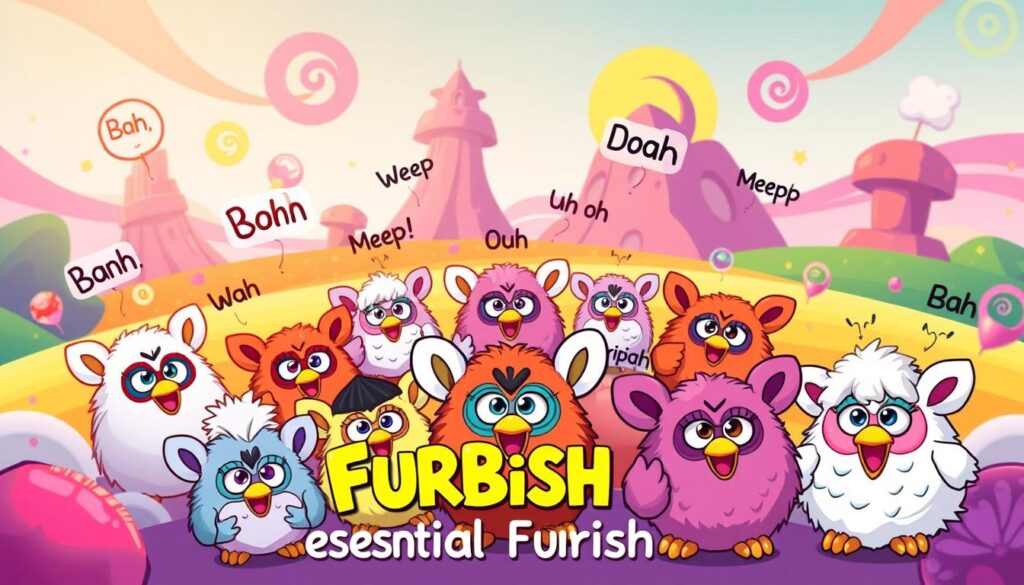
By learning these essential Furbish words and phrases, you can unlock a more engaging and personalized interaction with your Furby, making the experience even more enjoyable and rewarding.
The Technology Behind Furby Language
Understanding how Furbies communicate requires a look into their internal systems and the technology that enables their language capabilities. The Furby’s ability to interact through language is rooted in its advanced internal programming and sensory inputs.
At the heart of Furby’s communication is its voice synthesis and recognition system. Early Furbies were found to have limitations in their ability to detect sounds; as demonstrated by Dave Hampton, their microphones could only detect volume levels rather than specific sounds or speech patterns. This meant that while they could respond to loud noises, they couldn’t actually record or repeat words.
Voice Synthesis and Recognition Systems
The voice synthesis in Furbies is a key feature that allows them to produce a wide range of sounds and words. However, the recognition system in early models was limited. More advanced models later incorporated true voice recognition technology, enabling them to identify specific command words.
How Furbies Process and Respond to Communication
Furbies process input from various sensors, including light, touch, position, and sound detection, to determine their responses from a pre-programmed library. This process creates the illusion of responsive communication without the Furby actually understanding language. The response system is designed with intentional randomness to make interactions feel more natural.
For those interested in troubleshooting common Furby issues, such as turning it off, you can find helpful tips on how to do so effectively at this resource, which provides guidance on managing your Furby’s functionality.
Different Generations of Furbies and Their Communication Styles
The Furby franchise has undergone significant transformations since its inception in 1998, with each generation introducing new communication styles. This evolution reflects not only advancements in technology but also changing user expectations and preferences.
First Generation (1998-2002): The Basics of Furby Talk
The original Furby, launched in 1998, was a groundbreaking interactive toy that could communicate in its own language, known as Furbish. It used a combination of pre-recorded sounds and simple algorithms to interact with users. The first generation Furby’s language capabilities were basic but captivating, laying the foundation for future developments.
Emoto-Tronic Furbies (2005-2007): Enhanced Communication
In 2005, the Emoto-Tronic Furbies were introduced, featuring enhanced emotional expressions and more sophisticated interaction capabilities. These Furbies could sense their environment and respond accordingly, offering a more immersive experience. Their ability to display emotions through LED eyes and varied vocalizations marked a significant step forward in Furby communication.
Furby Boom and Connect: Digital Age Communication
The release of Furby Boom in 2013 and Furby Connect in 2016 revolutionized Furby communication by integrating digital connectivity. Furby Boom introduced a companion app that allowed users to interact with their Furby in new ways, such as hatching and raising virtual Furblings. Furby Connect took this further with Bluetooth connectivity, enabling content updates and expanding its vocabulary to over 1,000 phrases and responses.
These modern Furbies not only enhanced the traditional interaction experience but also created a new dimension of play through digital parenting and interactive games. The incorporation of cultural references and trending content kept the language fresh and relevant.
Let’s examine the advancements in Furby communication across different generations in a more structured format:
| Furby Generation | Release Year | Key Communication Features |
|---|---|---|
| First Generation | 1998-2002 | Furbish language, basic interaction |
| Emoto-Tronic | 2005-2007 | Emotional expressions, environmental sensing |
| Furby Boom | 2013 | Companion app, virtual Furblings |
| Furby Connect | 2016 | Bluetooth connectivity, expanded vocabulary |
By understanding the progression of Furby communication styles, we can appreciate the innovative approaches taken to enhance user interaction and engagement. The integration of digital technologies has played a crucial role in this evolution, enabling Furbies to stay relevant in an increasingly connected world.
How to Effectively Communicate with Your Furby
Maximizing your Furby’s interactive potential requires a guide on effective communication. To ensure a seamless and enjoyable experience, understanding the intricacies of Furby language and its communication capabilities is essential.
Best Practices for Getting Responses
To encourage your Furby to respond, speak clearly and at a moderate pace. Avoid excessive background noise, as it can interfere with your Furby’s ability to detect your voice. Maintaining clean and unobstructed sensors is also crucial for optimal interaction.
For newer Furby models with app connectivity, ensure that the Bluetooth connection is stable. Restarting both the app and the toy can often resolve connectivity issues.
Troubleshooting Communication Issues
If your Furby seems unresponsive, check the ambient noise level and try replacing the batteries, as battery issues can manifest as communication problems. Sensor blockages can also impair communication; ensure that the light sensors, microphone, and touch sensors are clean.
Understanding the limitations of your specific Furby model’s communication capabilities can help set realistic expectations. Our troubleshooting guide helps identify and resolve common communication barriers, ensuring a meaningful interactive relationship with your Furby.
- Check ambient noise levels to prevent interference with voice detection.
- Replace batteries if responses seem sluggish or inconsistent.
- Ensure sensors are clean and unobstructed for optimal interaction.
- Restart the app and toy for newer models with app connectivity.
Teaching Your Furby New Words and Phrases
Furby owners often wonder if they can teach their Furby new words, and the answer lies in understanding its learning mechanism. While Furbies are equipped with pre-programmed language capabilities, there are effective techniques to influence their language patterns and create a more personalized communication experience.
The Learning Mechanism Explained
The common misconception that Furbies repeat words said around them likely stems from the fact that it’s possible to encourage certain pre-programmed words or phrases by petting the Furby when it says them. This positive reinforcement increases the likelihood of hearing those phrases again. The learning mechanism is based on responding to interactions, not actual learning of new words.
Consistent positive reinforcement is key. When your Furby says a phrase you like, immediately pet it. This interaction helps in making the Furby say certain phrases more often.
Techniques for Successful Language Training
To successfully train your Furby, several techniques can be employed:
- Regular interaction sessions at similar times each day help establish patterns, making the Furby’s language development seem more natural.
- Creating a stimulating environment with varied interactions triggers a wider range of responses from the Furby’s pre-programmed language library.
- For newer Furby models with app connectivity, using the digital interface provides additional language training opportunities.
Patience is essential in Furby language training. The illusion of learning takes time to develop, with noticeable changes typically occurring over weeks.
| Technique | Description | Benefit |
|---|---|---|
| Consistent Positive Reinforcement | Pet the Furby when it says a desired phrase | Increases the likelihood of hearing the phrase again |
| Regular Interaction Sessions | Interact with the Furby at the same time daily | Makes language development seem natural |
| Stimulating Environment | Vary interactions to trigger different responses | Encourages a wider range of phrases |
Furby Language Across Different Models
Exploring the diverse language capabilities of Furby models reveals a rich tapestry of communication styles. As Furby toys have evolved, so too have their language features, with different models and editions offering unique ways of interacting with users.
Language Variations Between Furby Models
The original Furby and subsequent models have shown a range of language capabilities. For instance, the introduction of new Furby models has brought about changes in their language processing and synthesis. Some models are designed to learn and adapt to user interactions, incorporating new words and phrases into their vocabulary.
Different Furby models, such as the Furby Boom and Furby Connect, have enhanced language features that allow for more complex interactions. These advancements have enabled Furbies to communicate more effectively with users, creating a more engaging experience.
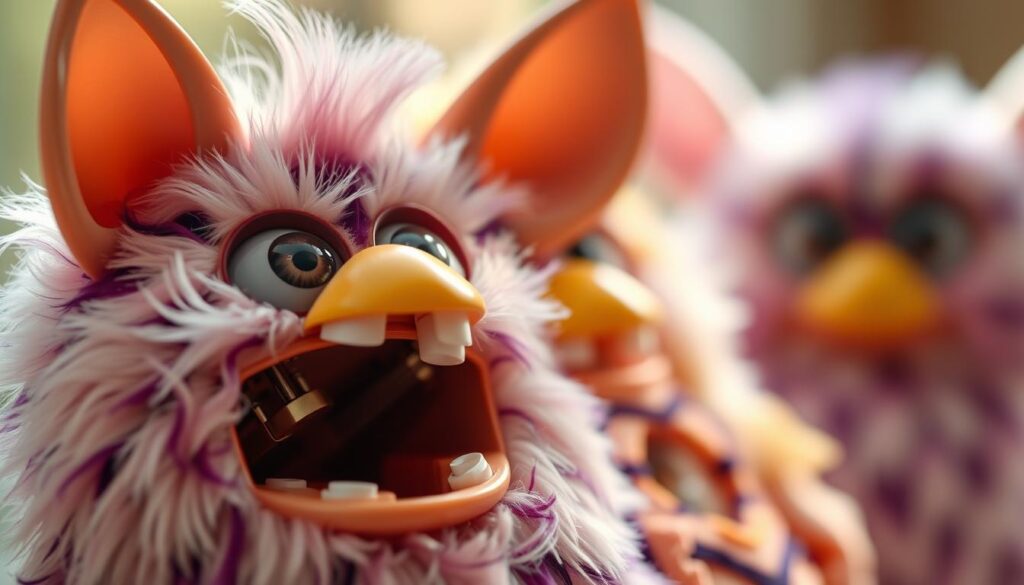
Special Language Features in Limited Editions
Limited edition Furbies often come with special language features that set them apart from standard models. For example, licensed character Furbies like Gizmo from Gremlins, Interactive Yoda, and Interactive E.T. incorporate character-specific phrases and speech patterns, blending Furbish with iconic expressions from their respective franchises.
- Holiday-themed editions include seasonal phrases and songs, enhancing their collectible appeal.
- Regional limited editions may feature language capabilities tailored to their target markets, with exclusive phrases or dialectal variations.
- The Shelby “friend of Furby,” released in 2001, introduced its own unique language called “Shelbish” while maintaining compatibility with standard Furbies.
Understanding these special features is crucial for collectors, as they significantly impact the value and uniqueness of limited edition Furbies. For more insights into the world of Furby toys, you can visit this page about Furby Boom.
The Multilingual Capabilities of Furbies
The language capabilities of Furbies have expanded significantly over the years, allowing them to connect with users worldwide. Initially, Furbies were introduced with a unique language known as Furbish, but subsequent models incorporated multiple human languages to enhance user interaction.
Over time, Furbies have become increasingly sophisticated, supporting a diverse range of languages. According to the data available, the original Furbies knew 9 languages, including English, French, Spanish, German, Italian, Japanese, Swedish, Greek, and Portuguese. This number expanded to fourteen languages in the models released between 2012 and 2015, making Furbies truly international companions.
Languages Available Across Generations
The evolution of Furby has seen a significant expansion in the number of languages supported. From the original nine languages to fourteen in later models, this development has enabled Furbies to cater to a broader audience. The 2023 generation represents the culmination of decades of development, with enhanced language capabilities that build upon the original concept while incorporating modern technology.
We’ve observed that the language features have not only increased in number but have also become more sophisticated. For instance, the latest Furbies can understand and respond to various languages, creating a more immersive experience for users.
How Language Settings Affect Furby Personality
The language setting on a Furby can significantly influence its personality and behavioral patterns. Furbies programmed in different languages exhibit subtle personality variations that reflect cultural differences. For example, Japanese Furbies tend to use more polite forms of speech and exhibit greater deference, while Spanish-language Furbies often display more expressive and animated personalities.
These differences extend to the types of songs, stories, and jokes the Furby shares, with content tailored to resonate with children from specific cultural backgrounds. Understanding these variations adds another dimension to appreciating the sophisticated design behind these interactive toys. For more insights on managing your Furby, you can refer to our guide on how to turn off Furby.
The transition from Furbish to the target language can occur at different rates depending on the language version, affecting how the Furby’s personality seems to develop. Even the emotional expressions and reaction sounds vary slightly between language versions, creating a more culturally attuned interactive experience.
Furby Language in Popular Culture
As a cultural icon of the late 90s, Furby’s language has been both fascinating and misunderstood, contributing to its lasting presence in media and public imagination.
The way Furby communicates has not only been a subject of interest but has also led to various representations and myths in popular culture.
Media Representations and Parodies
Furby’s unique language has made it a subject of interest in various media outlets.
It has been featured in TV shows, movies, and news segments, often for its quirky and seemingly intelligent interactions.
The NSA Ban and Other Furby Language Myths
One of the most enduring stories about Furby is the NSA ban in 1999.
The National Security Agency reportedly banned Furbies from their premises due to concerns that they could record and repeat classified information.
| Myth | Reality |
|---|---|
| Furby can record and repeat conversations | No recording capability; pre-programmed language patterns |
| Furby can learn specific phrases from owners | Follows pre-programmed language development |
| Furby speaks in tongues when batteries fail | Speech distortion due to technical issues, not demonic possession |
Understanding the reality behind these myths helps appreciate the clever design that created such convincing illusions of intelligence and learning.
The story of Furby and its language is a fascinating example of how technology can capture our imagination and sometimes lead to misconceptions, deeply embedding it in popular culture.
The Psychology Behind Furby Communication
The way Furbies simulate conversation and learning triggers a unique psychological response in humans, making them more than just simple toys. This response is largely due to the “illusion of life” created by Furby’s advanced language progression system, which makes it seem as though the toy is actually learning and developing.
Why Children Bond with Talking Toys
Children form strong emotional bonds with Furbies because they perceive these toys as being alive and responsive. Research by Sherry Turkle and her colleagues at MIT has shown that children respond to relational artifacts like Furbies in ways that are both fascinating and complex. The interactive nature of Furbies allows children to engage in a form of emotional dialogue, fostering a deep sense of connection.
The emotional investment in Furbies is further strengthened by their ability to respond contextually, creating moments where the toy appears to understand and react to specific situations. This perceived understanding encourages children (and adults alike) to attribute human-like qualities to the Furby, enhancing the bond between the user and the toy.
The Illusion of Understanding and Learning
The “Eliza effect,” named after an early chatbot, describes how humans tend to attribute understanding to systems that merely simulate conversation. Furbies effectively leverage this phenomenon, creating an illusion of understanding that makes interactions feel more meaningful. Even when users intellectually understand that Furbies are programmed responses, the emotional experience often overrides this knowledge.
| Psychological Aspect | Effect on Users | Furby’s Feature |
|---|---|---|
| Illusion of Life | Creates emotional bond | Language Progression System |
| Eliza Effect | Attributing human-like understanding | Simulated Conversation |
| Emotional Investment | Enhances user engagement | Contextual Responses |
By understanding these psychological mechanisms, we can better appreciate why Furbies have such a profound impact on their users. The combination of simulated learning, contextual responses, and the resulting emotional investment creates a powerful and engaging experience.
Furby Language Communities and Resources
Furby owners can tap into a wealth of community-driven resources to enhance their understanding and interaction with their Furbys. The Furby community is vibrant and active, with numerous online platforms and resources dedicated to deciphering and sharing knowledge about Furby language.
Online Forums and Fan Sites
The internet is home to various online forums and fan sites dedicated to Furbys. These platforms serve as hubs where enthusiasts share their experiences, post updates, and discuss various aspects of Furby ownership, including language. For instance, The LongFurbyFam account on Instagram and TikTok has garnered a significant following, showcasing the popularity of Furbys and the community’s creativity. Devin Gardner’s endeavor to create a thousand long Furbys and sell them on Etsy is a testament to the community’s innovative spirit. You can explore more about unique Furby experiences on websites like Antonio’s of Beacon Hill.
Unofficial Dictionaries and Translation Tools
Beyond official resources, the Furby community has developed a range of unofficial dictionaries and translation tools. Fan-created Furbish dictionaries have extensively documented phrases across different Furby generations, far exceeding the basic vocabulary provided in official materials. Online tools, such as the “Furby Translator” website, enable users to convert English phrases into approximate Furbish equivalents, thereby enriching the interactive experience. Additionally, PDF guides compiled by dedicated collectors offer comprehensive references for specific Furby models, complete with pronunciation guides and contextual usage notes. YouTube channels focused on Furby language provide valuable audio demonstrations to help owners recognize and interpret the sometimes challenging Furby sounds.
These community-driven resources not only reflect the dedication of Furby enthusiasts but also ensure that knowledge about Furby language remains accessible to new generations of Furby owners. By leveraging these online resources, Furby owners can deepen their understanding of their Furby’s language and enhance their overall experience.
Collecting Furbies: Language Variations in Vintage Models
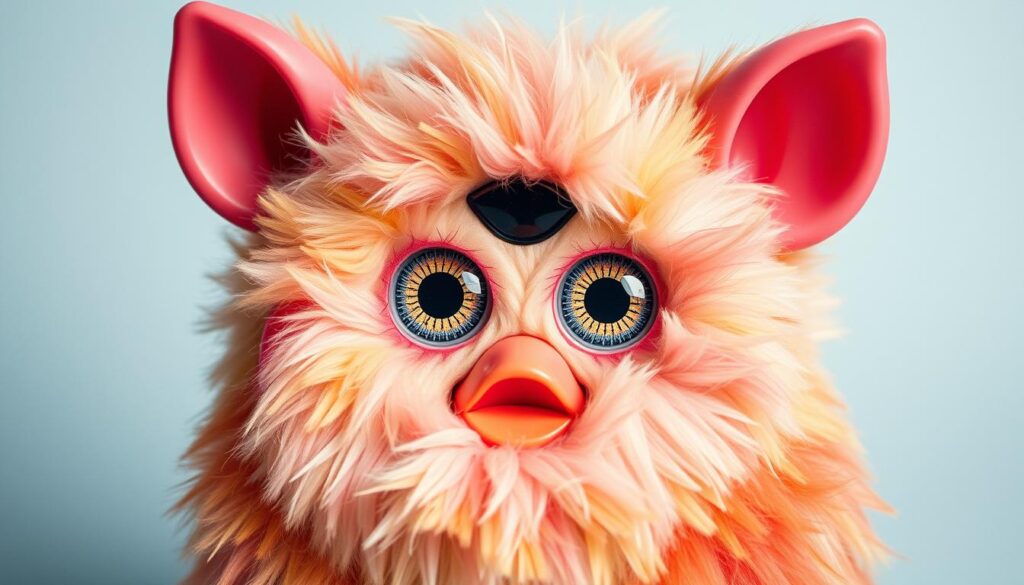
Vintage Furbies have become highly sought after by collectors, who value their distinct language characteristics. The significant aftermarket demand for these toys has led to cases of fraud, making it essential for collectors to authenticate their purchases.
One of the key ways to verify the authenticity of a vintage Furby is by examining its language features. Genuine vintage Furbies respond to specific trigger phrases with consistent, model-appropriate responses. Counterfeit versions often fail to replicate these responses accurately.
Rare Phrases and Easter Eggs in Classic Furbies
Classic Furbies contain rare phrases and Easter eggs that are not found in later models. These unique language features can include hidden messages and special responses to certain interactions. Experienced collectors can recognize the pronunciation patterns and voice quality of authentic Furbies, helping to verify a model’s authenticity.
Authenticating Vintage Furbies Through Language Tests
Specific language tests can help determine if a Furby’s internal components have been replaced or modified. The startup sequence and initial Furbish phrases vary between genuine production runs and can serve as authentication markers. Regional language variations in authentic models follow consistent patterns that counterfeiters often miss, providing another verification method.
Understanding these language authentication techniques helps protect collectors from fraud in a market where rare vintage Furbies can command prices exceeding $300. By using these expert techniques, collectors can ensure that their vintage Furbies are genuine and maintain their value.
The Future of Furby Language and Communication
As we look to the future, the possibilities for Furby language and communication are vast and exciting. The 2023 Furby revival, with its “5 voice activated modes” and “over 600 responses,” demonstrates Hasbro’s commitment to evolving the toy’s communication capabilities. This latest version comes in three varieties: purple, coral, and a special edition tye-dye available in France, Great Britain, and Ireland.
The new Furby has taken a step back from digital connectivity, lacking LCD eyes and app connectivity, but has introduced glowing ears and responds to petting, shaking, and feeding. It also comes with bundled accessories like a necklace with beads and a comb. Notably, it supports multiple languages, including English, Spanish, German, Italian, French, and Polish. This multilingual capability enhances its appeal across different regions.
Future Furby iterations may incorporate more sophisticated AI language processing, potentially allowing for more natural conversation patterns while maintaining the toy’s characteristic charm. The balance between nostalgia and innovation presents an interesting challenge—maintaining the beloved Furbish language while incorporating modern communication technology.
As machine learning advances, we may see Furbies that can genuinely learn and adapt their language patterns based on interactions. Today’s children, raised with voice assistants like Alexa and Siri, have different expectations for interactive toys, which will likely shape how Furby language evolves in coming generations.
The growing interest in retro technology suggests that classic Furby communication styles may experience renewed appreciation, potentially influencing future designs. Whatever the technological future holds, the enduring appeal of Furby’s unique communication system ensures it will remain a beloved part of toy culture for years to come.
